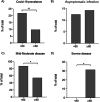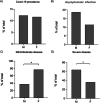COVID-19 and Mixed Cryoglobulinemia Syndrome: Long-Term Survey Study on the Prevalence and Outcome, Vaccine Safety, and Immunogenicity
- PMID: 36795264
- PMCID: PMC9933006
- DOI: 10.1007/s10875-023-01444-4
COVID-19 and Mixed Cryoglobulinemia Syndrome: Long-Term Survey Study on the Prevalence and Outcome, Vaccine Safety, and Immunogenicity
Abstract
Purpose: Mixed cryoglobulinemia syndrome (MCs) is a rare immunoproliferative systemic disorder with cutaneous and multiple organ involvement. Our multicenter survey study aimed to investigate the prevalence and outcome of COVID-19 and the safety and immunogenicity of COVID-19 vaccines in a large MCs series.
Methods: The survey included 430 unselected MCs patients (130 M, 300 F; mean age 70 ± 10.96 years) consecutively collected at 11 Italian referral centers. Disease classification, clinico-serological assessment, COVID-19 tests, and vaccination immunogenicity were carried out according to current methodologies.
Results: A significantly higher prevalence of COVID-19 was found in MCs patients compared to Italian general population (11.9% vs 8.0%, p < 0.005), and the use of immunomodulators was associated to a higher risk to get infected (p = 0.0166). Moreover, higher mortality rate was recorded in MCs with COVID-19 compared to those without (p < 0.01). Patients' older age (≥ 60 years) correlated with worse COVID-19 outcomes. The 87% of patients underwent vaccination and 50% a booster dose. Of note, vaccine-related disease flares/worsening were significantly less frequent than those associated to COVID-19 (p = 0.0012). Impaired vaccination immunogenicity was observed in MCs patients compared to controls either after the first vaccination (p = 0.0039) and also after the booster dose (p = 0.05). Finally, some immunomodulators, namely, rituximab and glucocorticoids, hampered the vaccine-induced immunogenicity (p = 0.029).
Conclusions: The present survey revealed an increased prevalence and morbidity of COVID-19 in MCs patients, as well an impaired immunogenicity even after booster vaccination with high rate of no response. Therefore, MCs can be included among frail populations at high risk of infection and severe COVID-19 manifestations, suggesting the need of a close monitoring and specific preventive/therapeutical measures during the ongoing pandemic.
Keywords: COVID-19 vaccine; SARS-CoV-2; cryoglobulinemic vasculitis; immunogenicity; mixed cryoglobulinemia.
© 2023. The Author(s), under exclusive licence to Springer Science+Business Media, LLC, part of Springer Nature.
Conflict of interest statement
The authors declare no competing interests.
Figures



References
-
- Ferri C, Sebastiani M, Giuggioli D, Colaci M, Fallahi P, Piluso A, et al. Hepatitis C virus syndrome: a constellation of organ- and non-organ specific autoimmune disorders, B-cell non-Hodgkin's lymphoma, and cancer. World J Hepatol. 2015;7(3):327–343. doi: 10.4254/wjh.v7.i3.327. - DOI - PMC - PubMed
Publication types
MeSH terms
Substances
LinkOut - more resources
Full Text Sources
Medical
Miscellaneous

